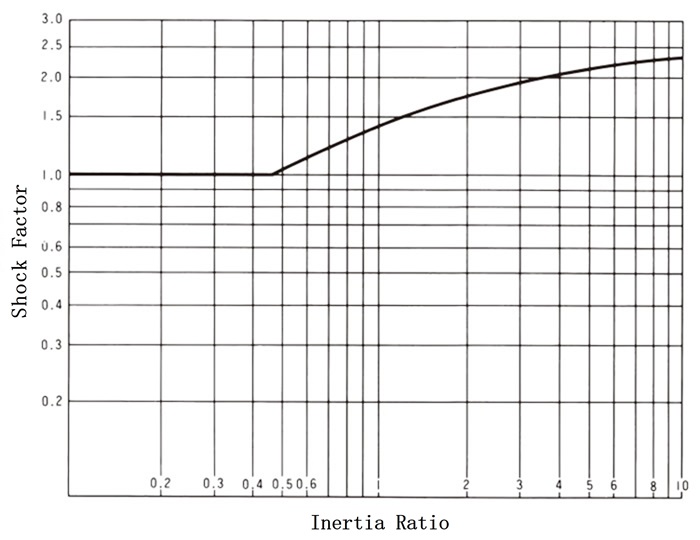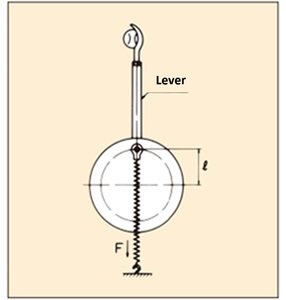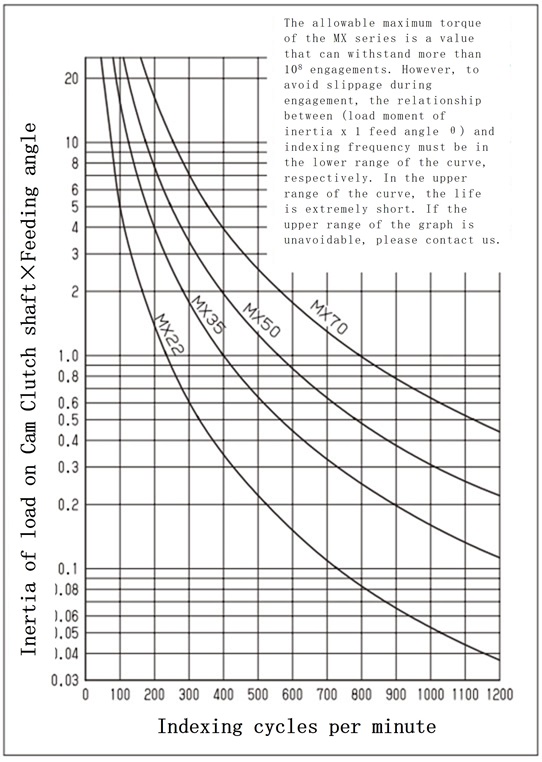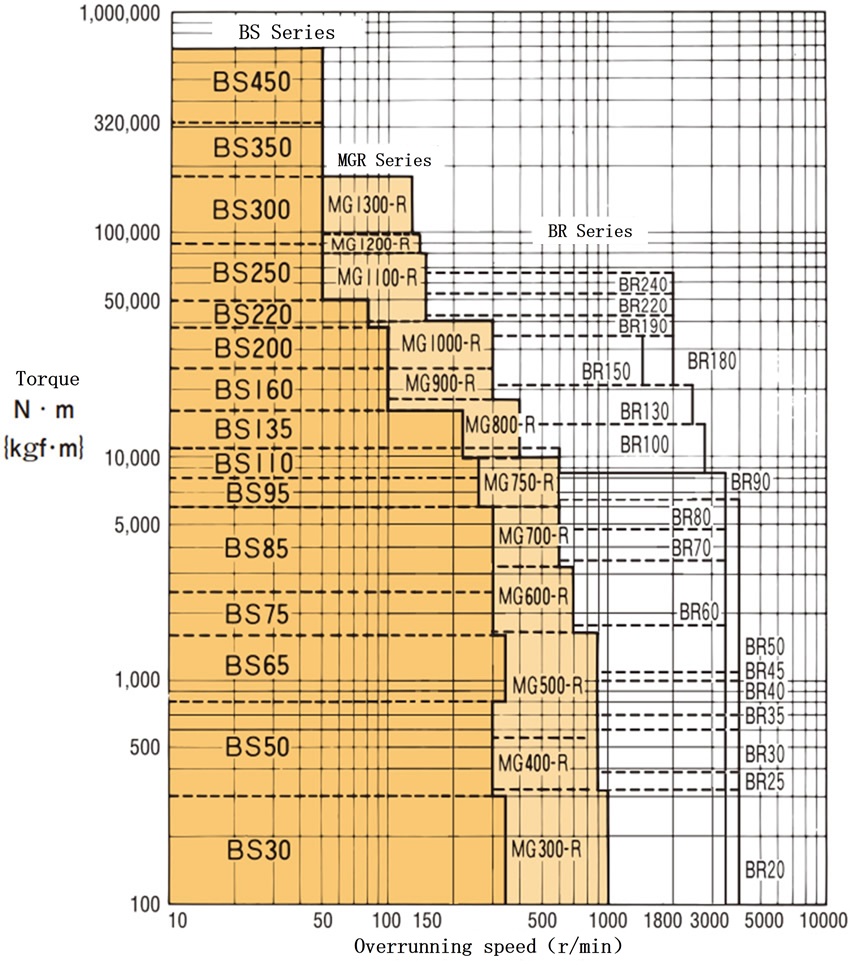Technical Data Clutches Selection
To view selection procedures and precautions, please proceed to the following.
Click here to narrow down the product series or to make a tentative selection.
Selection Method
Clarify the mode of cam clutch (overrunning, indexing, backstopping). Since the selection method differs for each mode, follow the respective procedure to select a cam clutch. In the case of the following model numbers, please contact us.
- (1)Cam Clutch Boxes
- (2)Clutch for feed with stopper (indexing)
1.Overrunning
- (1)Calculate the torque on the Cam Clutch according to the formula below.
Torque formula
SI Unit T = 60000 × kW 2π × N × S.f(N・m)
{Gravity unit } T = 974 × kW N × S.f{kgf・m}
T Loaded torque on Cam Clutch (N・m) kW Transmitted power (kW) N Speed of Cam Clutch shaft rotation (r/min) S.f Service factor (Table on the right ) Service factor table
Conditions S.f No shock load 1~1.5 Moderate shock load 1.5~2.5 Shock load 2~3 Heavy shock load 4~6 - (2)Maximum Overrunning Speed
- (3)Shaft Bore Diameter
- (4)Installation method
- (5)others (Atmosphere conditions, maintenance, etc. )
Select a clutch that satisfies the above conditions from the clutches for overrunning (see the list of applicable series by mode and their respective pages).
| Series | |||||||||||||||||||
|---|---|---|---|---|---|---|---|---|---|---|---|---|---|---|---|---|---|---|---|
| Application | MZ MZ-G |
BB | PB | 200 | LD | ML | MG | MI | MX | MI-S | BS | BR BR(P) |
MG-R | MA | MR | Cam Clutch Boxes | MZ-C | MG-C | |
| Dual Drive ・ Two Speed Drive |
high speed disengaged; high-speed engaged | ○ | ◎ | ○ | |||||||||||||||
| High speed disengaged; low-mid speed engaged | ◎ | ◎ | ◎ | ||||||||||||||||
| high speed disengaged; low speed engaged | ◎ | ◎ | ◎ | ◎ | |||||||||||||||
| low-mid speed disengaged; low-mid speed engaged | ◎ | ○ | ○ | ○ | ○ | ○ | ○ | ◎ | ○ | ||||||||||
| engage in one-way direction, overrun in reverse direction | ◎ | ○ | ○ | ○ | ○ | ○ | ○ | ○ | ◎ | ○ | |||||||||
| free wheeling | ◎ | ○ | ○ | ○ | ○ | ○ | ○ | ◎ | ◎ | ○ | |||||||||
| manual drive | ○ | ○ | ○ | ◎ | ◎ | ○ | |||||||||||||
If the service factor (S.f.) is unknown, use the following procedure.
S.f = Starting torque of mover % × Shock factor (Maximum 2.5)
Shock factor is,
Inertia ratio =
Load inertia on clutch shaft
(Clutch shaft conversion )
Input inertia on clutch shaft
(Clutch shaft conversion )
should be calculated from the figure below.
Shock factor

2.Indexing
2.1 Cam clutch for indexing feed
- (1)Calculate the torque applied to the cam clutch using formula A or B.
Note) The above formula is not applicable to indexing not by crank mechanism. Formula A
T = I・θ・N2 101750 + TB
T Loaded torque on Cam Clutch N・m I Inertia of load on Cam Clutch shaft (Can clutch shaft conversion ) kg・m2 θ Feeding angle (Can clutch shaft conversion ) N Indexing cycles per minute TB Brake torque calculated on Cam Clutch shaft N・m(Can clutch shaft conversion ) Formula B
T = 60000 × P 2π × n ・ ℓ2 ℓ1 × 2.5
T Loaded torque on Cam Clutch N・m P Power transmission kW n Speed of crank shaft r/min ℓ1 Length of crank m ℓ2 Length of lever on Cam Clutch m 2.5 Factor - (2)Maximum indexing cycles
- (3)Feeding angle (θ) 90° or less except for MI-S series
- (4)N × θ ≦ 20000(high-mid speed; small feed angle )
N × θ ≦ 50000(low speed; large feed angle ) - (5)Expected accuracy
Use the MX series, especially when high accuracy feed is expected.
In addition, use high accuracy backstopping clutches and brakes. - (6)Shaft Bore Diameter
- (7)Installation method
- (8)others (Life, maintenance, etc. )
Select a clutch that satisfies the above conditions from the clutches for indexing (see the list of applicable series by mode and their respective pages).
| Series | ||||||||||||||||||
|---|---|---|---|---|---|---|---|---|---|---|---|---|---|---|---|---|---|---|
| Application | MZ MZ-G |
BB | PB | 200 | LD | ML | MG | MI | MX | MI-S | BS | BR BR(P) |
MG-R | MA | MR | Cam Clutch Boxes | MZ-C | MG-C |
| high speed; small feed angle | ◎ | |||||||||||||||||
| low-mid speed; small feed angle | ○ | ○ | ○ | ○ | ○ | ○ | ◎ | ○ | ○ | |||||||||
| low speed; large feed angle | ◎ | |||||||||||||||||
| backstop device for indexing | ○ | ○ | ○ | ○ | ○ | ○ | ◎ | ◎ | ○ | |||||||||
| indexing furnished with stopper | Contact us for more information. | |||||||||||||||||
| infinite variable feed | ○ | ○ | ○ | ○ | ○ | ○ | ○ | ◎ | ||||||||||
2.2 Backstopping with indexing feed
Use the same model number as the feed cam clutch or one size smaller.
Furthermore, if you are using the MX series, make sure that it is in the lower range of the respective curves in the graph below.
Range of use of the MX series
3.Selection method for backstopping
3.1Torque calculation for cam clutch
(1)Backstopping for belt conveyor
[Steps 1] Calculate the power to move an empty belt and idlers: (P1) P1 = 0.06 × f × W × V × ℓ + ℓ0 367 (kW)
[Steps 2] Calculate the power to move a loaded belt horizontally: (P2) P2 = f × Qt × ℓ + ℓ0 367 (kW)
[Steps 3] Calculate the power to move the load vertically: (P3) P3 = h × Qt 367 (kW)
[Steps 4] Calculate the back stop power: (Pr) Pr = P3 - 0.7(P1 + P2)(kW)
[Steps 5] Calculate the back stop torque: (T) SI Unit T = 60000 × Pr 2π × N × S.f(N・m) {Gravity unit } T = 974 × Pr N × S.f{kgf・m}
- f = Friction coefficient of rollers
= 0.03(normally used ) - W = Weight of moving parts of the conveyor in the unloaded condition {kg/m}
(Use the values from the table below. )Belt width mm 400 450 500 600 750 900 1050 1200 1400 1600 1800 2000 Mass W 22.4 28 30 35.5 53 63 80 90 112 125 150 160 - V = Conveying speed m/min
- Qt = Max. possible load t/h
- h = Total lift m
- ℓ = Horizontal distance between head pulley and tail pulley m
- ℓ0 = Modification coefficient for horizontal distance m
= 49m(normally used ) - N = Shaft speed (r/min) on which the clutch is mounted. r/min
- S.f = Service factor
(Select service factor from table below: )Backstopping: Several times a day 1.5 Backstopping: More than several times a day 2.0
(2)Backstopping for bucket elevator
[Steps 1] Calculate the back stop torque: (T)
SI Unit T =
(L + D) × Qt × D × 9800
120 × V
× S.f(N・m)
{Gravity unit } T =
(L + D) × Qt × D × 1000
120 × V
× S.f{kg・m}
[Steps 2] Select a size for which the above back stop torque (T) is within the allowable maximum torque.
- Note) 1.When calculating the back stop torque, it is recommended that the maximum conveying capacity (Qt) be the largest value that can be considered for the conveyor's capacity. An unexpected reverse of a conveyor often occurs when the conveyor reaches its full load capacity.
- Note) 2.For conveyors other than those mentioned above, back stop torque should be calculated separately using formulas specific to each conveyor. In this case, too, the calculation should be based on the assumption that the load is applied to the full capacity of the conveyor.
- L = Total lift m
- D = Pitch circle dia. of head sprocket m
- Qt = Max. possible load t/h
- V = Conveying speed m/min
- S.f = Service factor
(Select service factor from table below: )Backstopping: Several times a day 1.5 Backstopping: More than several times a day 2.0
- T = Motor trip torque
- kW = Motor Capacity (kW)
- N = Cam clutch overrun rotation speed r/min
- S = Motor stall torque %
- Tmax = Max. allowable torque in catalog
(3)Selection by motor trip
If there is a possibility that the motor may trip and stop due to trouble during conveyance or wiring errors, use the following formula for selection.
SI Unit T = 60000 × kW 2π × N × S 100 ≦ Tmax(N・m)
{Gravity unit } T = 974 × kW N × S 100 ≦ Tmax{kgf・m}
Note) The above selection formula is for BS series. For other series, please contact us.
(4)Backstop with repetitive impact load (Tennis machines, pitching machines, etc. )
Required torque calculation
T = F × ℓ × 3.0
- T:Torque on cam clutch (N・m)
- F:Maximum spring pull tension (N)
- ℓ:Eccentricity (Load )
- 3.0:Factor
3.2 Overrun rotation speed
3.3 Shaft Bore Diameter
3.4 Installation method

Select a clutch that satisfies the above conditions from the clutches for backstopping (see the list of applicable series by mode and their respective pages).
| Series | ||||||||||||||||||
|---|---|---|---|---|---|---|---|---|---|---|---|---|---|---|---|---|---|---|
| Application | MZ MZ-G |
BB | PB | 200 | LD | ML | MG | MI | MX | MI-S | BS | BR BR(P) |
MG-R | MA | MR | Cam Clutch Boxes | MZ-C | MG-C |
| low speed overrun | ○ | ○ | ○ | ○ | ○ | ○ | ○ | ◎ | ○ | |||||||||
| medium speed overrun | ○ | ○ | ○ | ○ | ○ | ○ | ◎ | |||||||||||
| high speed overrun | ○ | ◎ | ◎ | ○ | ||||||||||||||
| Backstopping due to reciprocating shock loads | ◎ | |||||||||||||||||



